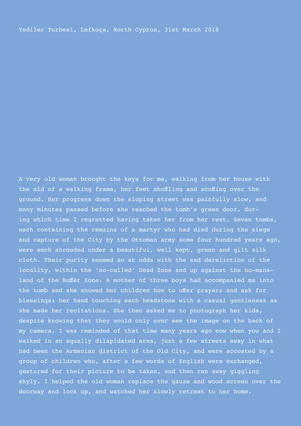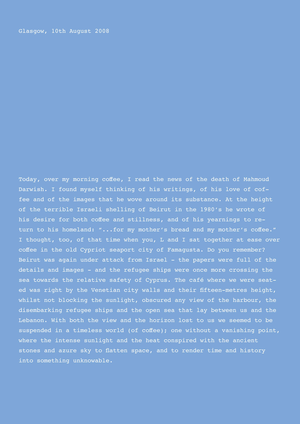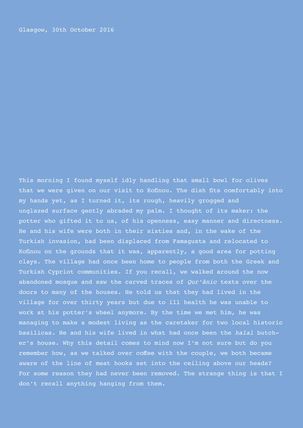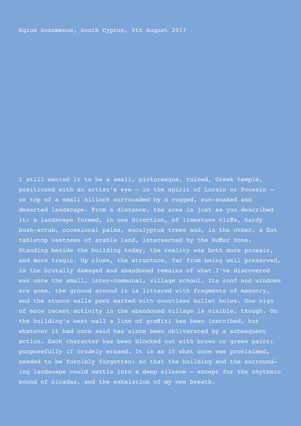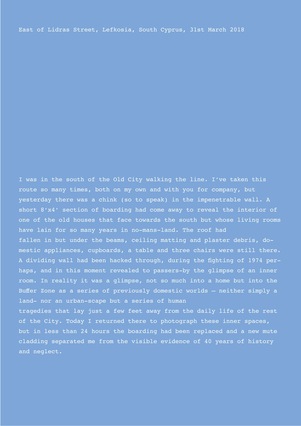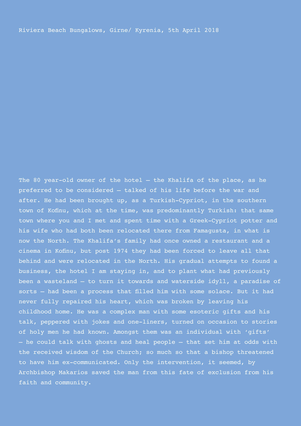Coffee Letters (extract)
The coffee drinker as liminal observer
This series of letters, written collaboratively by Glasgow-based artists Susan Brind & Jim Harold, are extracted from an on-going larger project that goes under the working title Coffee Letters. The letters reference observations, events and encounters that have been witnessed together or individually since the turn of the 20th-21stCentury. The particular letters published here are drawn from research journeys undertaken on Cyprus over a period of just over 20 years, although the larger body of writings from which they are extracted relate to peripheral and border locations within the UK, mainland Europe and Scandinavia[1].
Written jointly, the letters assume the voice of an anonymous ‘I’ and are written to an unnamed ‘you’, whose location is unspecified. The letters forge a relationship – by means of reflecting upon historical and current events, and moments suggested as shared – that reaches across continents, cultures and time. Incorporating empirical knowledge, fieldwork, direct observation, reflexive and auto ethnographic methods, they are located in the world of a coffee drinker as liminal observer: absorbed in a transitory world of passage, relative nostalgia, and melancholy. The state provided by this space is one of presence and reflection on cultural, social and political conditions, and is informed by the early political commentary of Christopher Hitchins[2], the ethnographic writings of Yiannis Papadakis[3] and Yael Navaro-Yashin[4] all directly dealing with the aftermath of the 1974 War, the literature and aesthetics of vernacular cosmopolitanism and the tension of borders identified by Stephanos Stephanides and Stavros Karayanni[5], and the strategies of open space appropriations by Stavros Stavrides[6]. It acknowledges, too, the detail of everyday life and place discoursed upon by Michel de Certau[7].
Events, locations, musings, and conversations recalled, are laid down on the page to ‘you’. A bond between writer(s) and reader is forged for the duration of each text, each memory. Each location or place is momentarily combined or joined as a shared experience of ‘being’ – of existential experience – that temporarily brings into proximity feelings of remoteness and closeness, of knowing and unknowability in the terms of Yves Bonnefoy[8]. They are, however, not complete letters. There is no direct addressee and no form of signing off. They retain a form of anonymity, both of the sender and the recipient. They are, in a very real sense, fragments of a letter, and the idea of the fragment is key to their form and intention. They are not complete moments, fully framed or brought to any conclusion. In this regard each letter becomes a moment of pause or passage between two senses of place, the one predicated by its nature as a fragment and the other by an invoked sense of loss[9]. As such, they suggest a series of hinterland-like spaces, much like Yves Bonnefoy’s notion of the Arriès-pays, that can only be glimpsed or glanced at[10]. They are, too, about the world of experience and phenomena; of thought and feeling. Each text frames a moment that evolves in its own terms whilst relating to other fragments by means of the series, following an invisible line to a next, and another next, and so on, while in the process mixing connections to establish a new relation, that Maurice Blanchot suggests considers, the Outside[11]: that which resides beyond or outside of the text.
The concept of the fragmentary view held within the letters is particularly relevant to the context of Cyprus. The divided island precludes a view of the united whole, and the Buffer Zone which spans the whole island, East to West, provides the physical periphery of each nation state. The letters, written from both the North and the South register that peripheral state most potently when located in Nicosia: the divided city at the very heart of the island. Within the walls that, during the Venetian period, protected the whole City, the sounds, smells, visual glimpses of parallel worlds that once were one, collide and drift across from the North (the Turkish Republic of Northern Cyprus) to the South (the Republic of Cyprus) and back again.
The letters acknowledge that the traveller, however, can only ever experience a fragmented, subjective, and partial view of a place, and are contextualised within the long history of letter writing from travellers. According to the testimony of the ancient historian Hellanicus, the first recorded handwritten letter was written by the Persian Queen Atossa, in approximately 500 BC. And in more recent history, particularly in the C18th, the conceit of letters, ostensibly written to a lady, as a vehicle for describing events and unfolding a narrative became more common. One such example is: ‘Letters to a Lady’: a series of adventures in the course of a voyage up the Red Sea … and a Route through the Deserts of Arabia written by Eyles Irwin, first published in 1780.
There is a clear tradition too of using the journey as a means for reaching some direct experiential knowledge or understanding of the world. Whether that knowledge was coloured by the gaze of the observer in a positive manner (for example, Victor Segalen reflecting on his experiences in East Asia[12]) or in a negative way (as discussed by Edward Said in his seminal work, Orientalism[13]), the dynamics of otherness is an essential factor in travel narratives. It is as apparent in writings from within the European context as it is in other cultures.
Herodotus’ Histories, written in 440BC, recorded traditions, politics, geography and cultures from across the then known Ancient world. In the Arab world, the rihla tradition has sustained since the C14th. Rihla literally translates as a narrative of a voyage in search of knowledge, often in the form of a pilgrimage. The 12thCentury al-Andalus geographer and poet, Ibn Jubayr, who undertook the pilgrimage to Mecca between 1183-85, and the 14thCentury Moroccan scholar, Ibn Battuta, who having performed the Pilgrimage in 1325-1326 travelled on for a further thirty years in a search of earthly knowledge, are particularly interesting examples[14]. Other forms of Pilgrim narratives exist from before and since that time, and from different cultures and faiths. One example being Egiria, a Galecian woman pilgrim, whose letter to a circle of women, Itinerarium Egeriae, written in the 4thCentury, describes her journey – probably undertaken in the 380s CE – to the sacred city of Jerusalem and the Sinai desert. A more contentious example is that by the 14thCentury Crusader Knight, a work known as The travels of Sir John Mandeville (first circulated around 1357 or 1371), which unreliably describes his probable journey as a crusader knight to the Holy Land and then travels into a fictional ‘beyond’ in quest of the mythical Prester John[15]. All of these writings are a mixture of first-hand experience and secondary knowledge of the time, gained from stories told or transmitted by writing, and from libraries too. The same sources are as relevant now as then but seeing for oneself surpasses all other knowledge.
[1] The Coffee Letters' first iteration was two letters: one from North Nicosia and from Glasgow, written in the mid-2000s. Since then the enlarged body of work has found form in the following places:
2015 ‘Foreign Encounter’, Gallery Foe, Munich: where a letter from Ipswich (current with news of mass migration) was added.
2016 ‘Burning Sands: Vol 5’: included the three existing letters with the addition of one from Oxford on Percy Byshe Shelley who drowned in the Mediterranean.
2016 ‘Bitter Rose … For you’, Woodside Library, Glasgow as part of the
‘Bitter Rose’ project for Glasgow International 2016: installation of eight letters and readings.
2016 CCFT Exhibition and Colloquium, Department of Architecture, University of Nicosia: an exhibition of nine letters and readings performed as a conference paper.
2017, 2018 and 2019 Further letters written and integrated in academic texts for conferences in Cyprus, Sheffield and Glasgow, and included in the book chapter: “At the limits of reliable information”: Finland’s Arctic borders with Sweden, Norway and Russia, in Chris Goldie and Darcy White (eds), Northern Light: Landscape, Photography and Evocations of the North, transcript Verlag, Bielefeld, 2018.
The series currently comprises over forty letters.
[2] Hitchens, Christopher. Hostage to History: Cyprus from the Ottomans to Kissinger, London & New York: Verso, 1997.
[3] Papadakis, Yiannis. Echoes from the Dead Zone: Across the Cyprus Divide, London & New York: IB Tauris, 2005.
[4] Navaro-Yashin, Yael. The Make-Believe Space: Affective Geography in a Postwar Polity, Durham & London: Duke University Press, 2012.
[5] Stephanides, Stephanos and Stavros Karayanni (eds.). Vernacular Worlds, Cosmopolitan Imagination, Cross/Cultures 81, Leiden, Netherlands: Brill, 2015.
[6] Stavrides, Stavros. ‘Open Space Appropriations and the Potentialities of a “City of Thresholds”’, in Mariani, Manuela & Patrick Barron (eds.), Terrain Vague: Interstices at the Edge of the Pale, London: Routledge, 2014, 48-61.
[7] De Certau, Michel. The Practice of Everyday Life, Steven F Rendall (trans.), Berkeley & Los Angeles: University of California Press, 1988 [1984].
[8] Bonnefoy, Yves. The Arrière-pays, Stephen Romer (trans.), London: Seagull Books, 2012 [1972], 170.
[9] Benjamin, Andrew. Present Hope: Philosophy, Architecture, Judaism, London: Routledge, 1997, 78.
[10] Bonnefoy, Yves. The Arrière-pays, Stephen Romer (trans.), London: Seagull Books, 2012 [1972], 168.
[11] Cited in: ‘The Fissure of Anaxagoras and the Local Fire of Heraclitus’ in Deleuze, Gilles. Desert Islands and other Texts 1953-1974, Pasadena: Semiotext(e), 2004, 157.
[12] Segalen, Victor. Essay on Exoticism: An Aesthetics of Diversity (Post-Contemporary Interventions), 1918, Durham & London: Duke University Press, 2002.
[13] Said, Edward. Orientalism: Western Conceptions of the Orient, London: Penguin Books, 1995.
[14] Ibn Jubayr. The Travels of Ibn Jubayr, R J C Broadhurst (trans), New Delhi: Goodword Books, 2001; Ibn Battuta. Travels in Asia and Africa, 1325-1354, H A R Gibb (trans), New Delhi: Oriental Books Reprint Co, 1986.
[15] Mandeville, Sir John. The Travels of Sir John Mandeville, C. Moseley (Intro), London: Penguin, Edition 2005.
